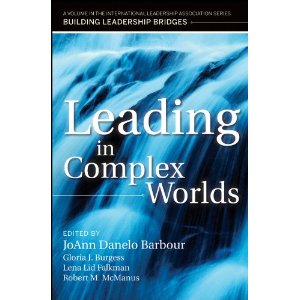Joann Danelo Barbour, Gloria J. Burgess, Lena Lid Falkman, Robert M. McManus, Eds. (2012). Leading in Complex Worlds, A Volume in the International Leadership Association Series, Building Leadership Bridges. San Francisco: Jossey-Bass
 Every year the International Leadership Association produces a book in their Building Leadership Bridges series. This volume sought contributions that were “multiperspetive in scope and focused on leading and leadership, and that would be appropriate for helping leaders develop the understanding needed to live and lead in complex worlds.” This statement lit me up.
Every year the International Leadership Association produces a book in their Building Leadership Bridges series. This volume sought contributions that were “multiperspetive in scope and focused on leading and leadership, and that would be appropriate for helping leaders develop the understanding needed to live and lead in complex worlds.” This statement lit me up.
Here, subtly presented, is attention to the kinds of distinctions that the leadership field so sorely needs. Note the ways world like leading, leader, and lead are used. They are not the same things and they need to be attended to differently. Hurrah! to the editors! And in a complex world! Clearly a link between what individuals may do, even in collectives, to context. It might have been better to say complex worlds, but what they said is excellent. And, although they are not yet using the terms, the editors were going for “multiperspectives, miultigrounded, multiframed, multidisciplinary, multimodal, multidimensional, multi-intelligent, and multilogical…” Leaves me wanting them to add or embrace these terms with transdisciplinary or even meta…
Each editor took responsibility for a different section of the book:
1. The Complexity of Leader Development, Robert McManus.
2. The Complexity of Leadership Practice, Gloria J. Burgess.
3. The Complexity of Leading in a Globalized World, Lena Lid Falkman.
McManus introduces Part One by stating that leadership studies can offer a body of knowledge, but that the “development of a leader, however, is a complex process that calls for time and reflection. This seems to be a recurring theme emerging recently in the field. It would be helpful if the focus was on the long term development of the individual “develop skills that ultimately MAY BE HELPFUL to them in leading people and organizations. (Emphasis Ed.)” We do not develop leaders. Individuals are in leader roles only in snapshots of the life of a systems. And we not only develop skills, but if we want to prepare individuals to be effective in their lives, relationships and systems, we need to help them find and implement in an ongoing process practices that build their awareness internally, behaviorally and in relation to cultures and systems. I doubt the editors and authors in this volume would disagree with this, but they might join with me in the frustration of trying to change how we language leadership and its related concepts.
Gloria Burgess takes us back to Max De Pree’s old lesson: “leadership is an act of becoming,” that “leaders must continually learn and develoip themselves to acquire and attune their repertoire of awareness, knowledge, rituals, instincts, habits, and skills to artfully approach myriad complexities of their worlds.” Oh, I love this stuff! It is all getting just too integral to avoid dancing down the hall.
Lena Falkman focuses on our need to understand the global context, “global leadership needs to be understood within a context of complexity.” In the process of globalizing leadership will become more holistic and consensus driven (Jeri Darling). Our ways of thinking and knowing about leadership need to become less Western Centric and more of a blending of perspectives from around the world. Caroline Fu and Richard Burgeon give us the “Tao Complexity Tool: Leading from Being”. They tell us about “Yin-yang-five-walks” or “five states of change” of “‘the system’ of five nature’s ‘activating force’ in yin-yang complementarity. Intriguing, no?
The editors and the International Leadership Association are to be congratulated on this refreshing volume.
